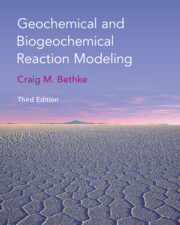Book contents
- Frontmatter
- Dedication
- Contents
- Preface
- Preface to Second Edition
- Preface to First Edition
- A Note About Software
- 1 Introduction
- 2 Modeling Overview
- PART I EQUILIBRIUM IN NATURAL WATERS
- PART II REACTION PROCESSES
- PART III APPLIED REACTION MODELING
- 26 Hydrothermal Fluids
- 27 Geothermometry
- 28 Evaporation
- 29 Sediment Diagenesis
- 30 Kinetics ofWater–Rock Interaction
- 31 Weathering
- 32 Oxidation and Reduction
- 33 Waste InjectionWells
- 34 Petroleum Reservoirs
- 35 Acid Drainage
- 36 Contamination and Remediation
- 37 Microbial Communities
- Appendix A Sources of Modeling Software
- Appendix B Evaluating the HMW Activity Model
- Appendix C Minerals in the LLNL Database
- Appendix D Nonlinear Rate Laws
- References
- Index
27 - Geothermometry
from PART III - APPLIED REACTION MODELING
Published online by Cambridge University Press: 09 December 2021
- Frontmatter
- Dedication
- Contents
- Preface
- Preface to Second Edition
- Preface to First Edition
- A Note About Software
- 1 Introduction
- 2 Modeling Overview
- PART I EQUILIBRIUM IN NATURAL WATERS
- PART II REACTION PROCESSES
- PART III APPLIED REACTION MODELING
- 26 Hydrothermal Fluids
- 27 Geothermometry
- 28 Evaporation
- 29 Sediment Diagenesis
- 30 Kinetics ofWater–Rock Interaction
- 31 Weathering
- 32 Oxidation and Reduction
- 33 Waste InjectionWells
- 34 Petroleum Reservoirs
- 35 Acid Drainage
- 36 Contamination and Remediation
- 37 Microbial Communities
- Appendix A Sources of Modeling Software
- Appendix B Evaluating the HMW Activity Model
- Appendix C Minerals in the LLNL Database
- Appendix D Nonlinear Rate Laws
- References
- Index
Summary
The objective of groundwater geothermometry is to use a groundwater’s chemistry to estimate the temperature at which it was last in equilibrium with its environment, to better understand the water’s origins. In this chapter, we explore the use of multicomponent chemical reaction modeling as a tool in geothermometry. We first construct a synthetic example to illustrate the calculation process. We then apply the modeling to better understand the chemistry of a hot spring in Iceland as well as geothermal water from that country.
Keywords
- Type
- Chapter
- Information
- Geochemical and Biogeochemical Reaction Modeling , pp. 331 - 344Publisher: Cambridge University PressPrint publication year: 2022

